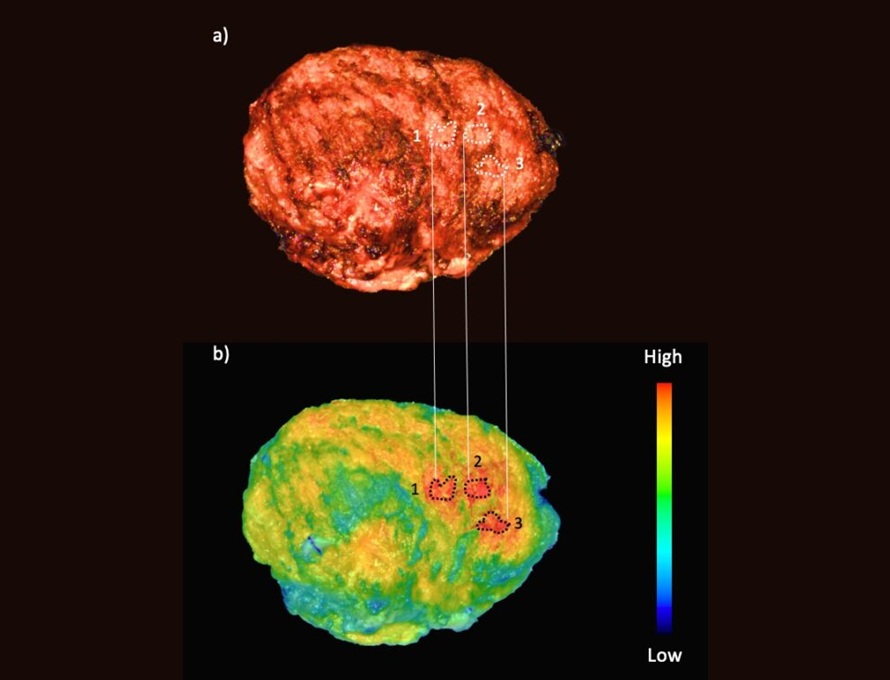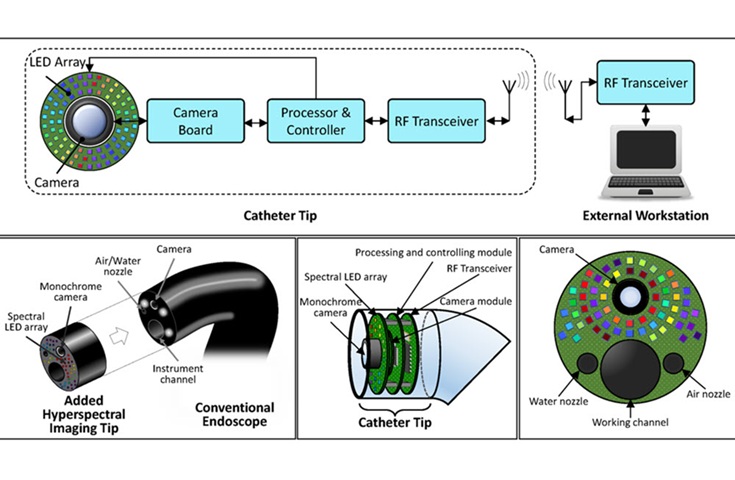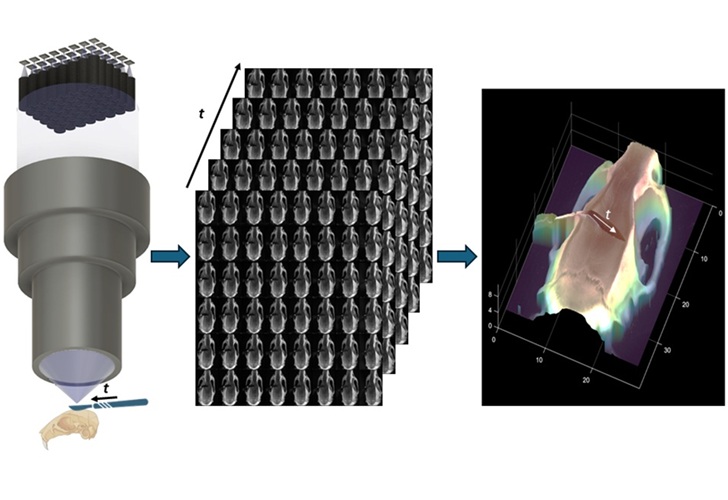High Brain Iron Hastens Alzheimer's Disease
|
By HospiMedica International staff writers Posted on 14 Jun 2015 |
High ferritin levels in the cerebrospinal fluid (CSF) could increase the risk of developing Alzheimer's disease (AD) and accelerate the cognitive decline that comes with it, according to a new study.
Researchers at the University of Melbourne (Australia), Cornell University (Ithaca, NY, USA), and other partners of the Alzheimer’s Disease Neuroimaging Initiative (ADNI; La Jolla, CA, USA) conducted a study to examine the possible link between brain iron levels and cognitive decline in three groups over seven years. Participants included 91 people with normal cognition, 144 people with mild cognitive impairment, and 67 people with diagnosed AD.
The researchers first determined participants’ brain iron levels by measuring the amount of ferritin in the CSF, which surrounds the brain. They continued to perform regular tests and magnetic resonance imaging (MRI) scans to track cognitive decline and changes in the brain over the study period. The results showed that people with higher levels of ferritin (in all groups) suffered faster declines in cognitive abilities, and accelerated shrinking of the hippocampus. Levels of ferritin were also a linked to a greater likelihood of people with mild cognitive impairment developing AD.
The researchers also found that higher levels of ferritin corresponded to earlier ages for diagnoses of AD, roughly three months for every 1 nanogram per milliliter increase. Another finding was that the ferritin was strongly associated with CSF apolipoprotein E (APOE-e4) levels, and that those participants with the AD risk allele, APOE-ɛ4, a gene variant which is known to be the strongest genetic risk factor for the disease, had the highest levels of iron in their brains. The study was published on May 19, 2015, in Nature Communications.
“We think that iron is contributing to the disease progression of Alzheimer's disease; this is strong evidence to base a clinical trial on lowering iron content in the brain to see if that would impart a cognitive benefit,” said lead author neuroscientist Scott Ayton, PhD, of the University of Melbourne. “Lowering CSF ferritin, as might be expected from a drug like deferiprone, could conceivably delay mild cognitive impairment conversion to Alzheimer's disease by as much as three years. Perhaps it's time to refocus the field on looking at iron as a target.”
AD, named after Dr. Alois Alzheimer, who first described it, is a physical disease that is the result of protein buildup in the brain, forming structures called plaques and tangles. These lead to the loss of connections between nerve cells, and eventually to their death and loss of brain tissue. As AD progresses, memory loss, communication, reasoning, and orientation become increasingly severe, and sufferers need more and more day-to-day support from those who care for them. AD affects almost 50% of those over the age of 85, and is the sixth leading cause of death in the US.
Related Links:
University of Melbourne
Cornell University
Researchers at the University of Melbourne (Australia), Cornell University (Ithaca, NY, USA), and other partners of the Alzheimer’s Disease Neuroimaging Initiative (ADNI; La Jolla, CA, USA) conducted a study to examine the possible link between brain iron levels and cognitive decline in three groups over seven years. Participants included 91 people with normal cognition, 144 people with mild cognitive impairment, and 67 people with diagnosed AD.
The researchers first determined participants’ brain iron levels by measuring the amount of ferritin in the CSF, which surrounds the brain. They continued to perform regular tests and magnetic resonance imaging (MRI) scans to track cognitive decline and changes in the brain over the study period. The results showed that people with higher levels of ferritin (in all groups) suffered faster declines in cognitive abilities, and accelerated shrinking of the hippocampus. Levels of ferritin were also a linked to a greater likelihood of people with mild cognitive impairment developing AD.
The researchers also found that higher levels of ferritin corresponded to earlier ages for diagnoses of AD, roughly three months for every 1 nanogram per milliliter increase. Another finding was that the ferritin was strongly associated with CSF apolipoprotein E (APOE-e4) levels, and that those participants with the AD risk allele, APOE-ɛ4, a gene variant which is known to be the strongest genetic risk factor for the disease, had the highest levels of iron in their brains. The study was published on May 19, 2015, in Nature Communications.
“We think that iron is contributing to the disease progression of Alzheimer's disease; this is strong evidence to base a clinical trial on lowering iron content in the brain to see if that would impart a cognitive benefit,” said lead author neuroscientist Scott Ayton, PhD, of the University of Melbourne. “Lowering CSF ferritin, as might be expected from a drug like deferiprone, could conceivably delay mild cognitive impairment conversion to Alzheimer's disease by as much as three years. Perhaps it's time to refocus the field on looking at iron as a target.”
AD, named after Dr. Alois Alzheimer, who first described it, is a physical disease that is the result of protein buildup in the brain, forming structures called plaques and tangles. These lead to the loss of connections between nerve cells, and eventually to their death and loss of brain tissue. As AD progresses, memory loss, communication, reasoning, and orientation become increasingly severe, and sufferers need more and more day-to-day support from those who care for them. AD affects almost 50% of those over the age of 85, and is the sixth leading cause of death in the US.
Related Links:
University of Melbourne
Cornell University
Latest Critical Care News
- Discovery of Heart’s Hidden Geometry to Revolutionize ECG Interpretation
- New Approach Improves Diagnostic Accuracy for Esophageal Motility Disorders
- Wristband Sensor Provides All-In-One Monitoring for Diabetes and Cardiovascular Care
- Handheld Device Enables Imaging and Treatment of Oral Cancer in Low-Resource Settings
- New Fully Automated AI Algorithm More Effective at Predicting Heart Attack Risk
- First-In-Kind Self-Assembling Collagen Scaffold Advances Wound Care
- AI-Enhanced Echocardiography Improves Early Detection of Amyloid Buildup in Heart
- Consumer Wearables Could Predict Pediatric Surgery Complications
- Wireless Implant Delivers Chemotherapy Deep into Tumors Without Side Effects
- Skin-Like Sensor Monitors Vital Signs and Tracks Healing After Surgery
- Implantable Device Could Save Diabetes Patients from Dangerously Low Blood Sugar
- New Prostate Screening Device Could Replace Traditional Examination Method
- Adaptive Spine Board to Revolutionize ER Transport
- Mapping Communication Between Internal Organs to Enable Earlier Illness Diagnosis
- Intelligent Wound Dressing Reduces Inflammation and Promotes Healing
- Cuff-Free Blood Pressure Monitoring Device to Improve Early Detection and Management of Hypertension
Channels
Surgical Techniques
view channel
Fluorescent Imaging Agent ‘Lights Up’ Nerves for Better Visualization During Surgery
Surgical nerve injury is a significant concern in head and neck surgeries, where nerves are at risk of being inadvertently damaged during procedures. Such injuries can lead to complications that may impact... Read more
LED-Based Imaging System Could Transform Cancer Detection in Endoscopy
Gastrointestinal cancers remain one of the most common and challenging forms of cancer to diagnose accurately. Despite the widespread use of endoscopy for screening and diagnosis, the procedure still misses... Read morePatient Care
view channel
Revolutionary Automatic IV-Line Flushing Device to Enhance Infusion Care
More than 80% of in-hospital patients receive intravenous (IV) therapy. Every dose of IV medicine delivered in a small volume (<250 mL) infusion bag should be followed by subsequent flushing to ensure... Read more
VR Training Tool Combats Contamination of Portable Medical Equipment
Healthcare-associated infections (HAIs) impact one in every 31 patients, cause nearly 100,000 deaths each year, and cost USD 28.4 billion in direct medical expenses. Notably, up to 75% of these infections... Read more
Portable Biosensor Platform to Reduce Hospital-Acquired Infections
Approximately 4 million patients in the European Union acquire healthcare-associated infections (HAIs) or nosocomial infections each year, with around 37,000 deaths directly resulting from these infections,... Read moreFirst-Of-Its-Kind Portable Germicidal Light Technology Disinfects High-Touch Clinical Surfaces in Seconds
Reducing healthcare-acquired infections (HAIs) remains a pressing issue within global healthcare systems. In the United States alone, 1.7 million patients contract HAIs annually, leading to approximately... Read moreHealth IT
view channel
Printable Molecule-Selective Nanoparticles Enable Mass Production of Wearable Biosensors
The future of medicine is likely to focus on the personalization of healthcare—understanding exactly what an individual requires and delivering the appropriate combination of nutrients, metabolites, and... Read more
Smartwatches Could Detect Congestive Heart Failure
Diagnosing congestive heart failure (CHF) typically requires expensive and time-consuming imaging techniques like echocardiography, also known as cardiac ultrasound. Previously, detecting CHF by analyzing... Read moreBusiness
view channel
Bayer and Broad Institute Extend Research Collaboration to Develop New Cardiovascular Therapies
A research collaboration will focus on the joint discovery of novel therapeutic approaches based on findings in human genomics research related to cardiovascular diseases. Bayer (Berlin, Germany) and... Read more

















